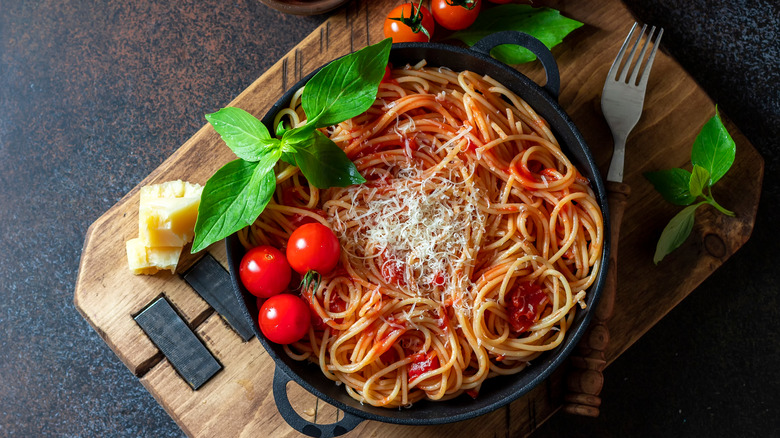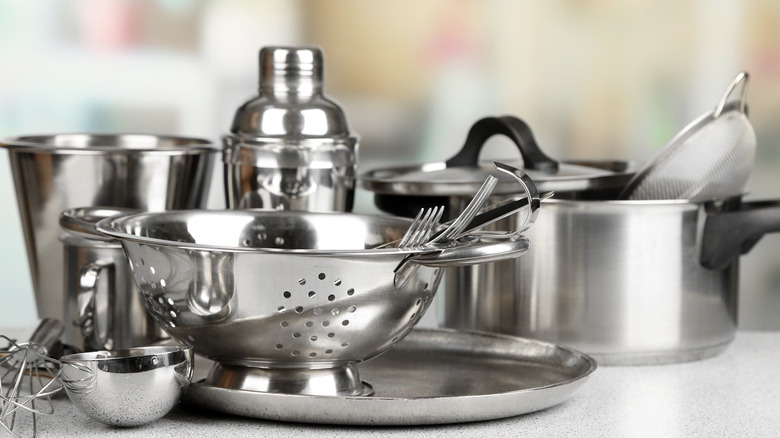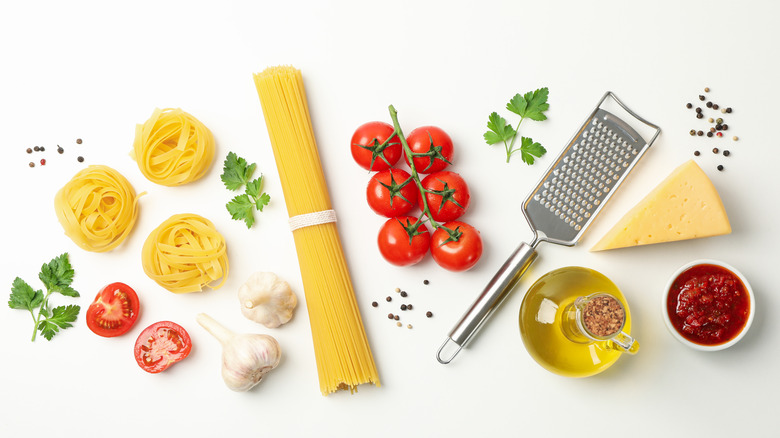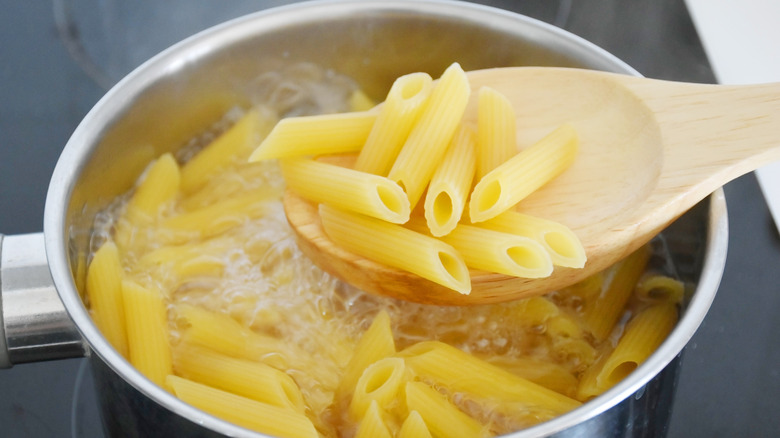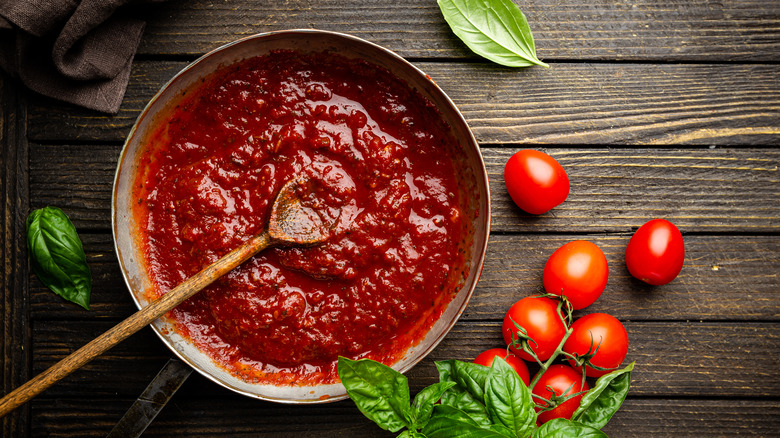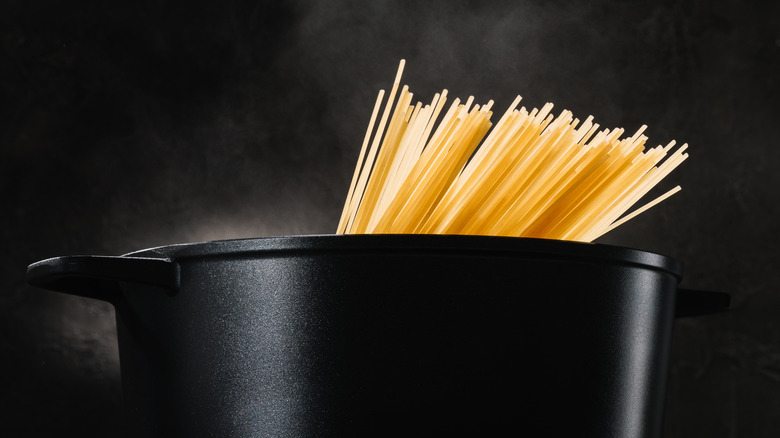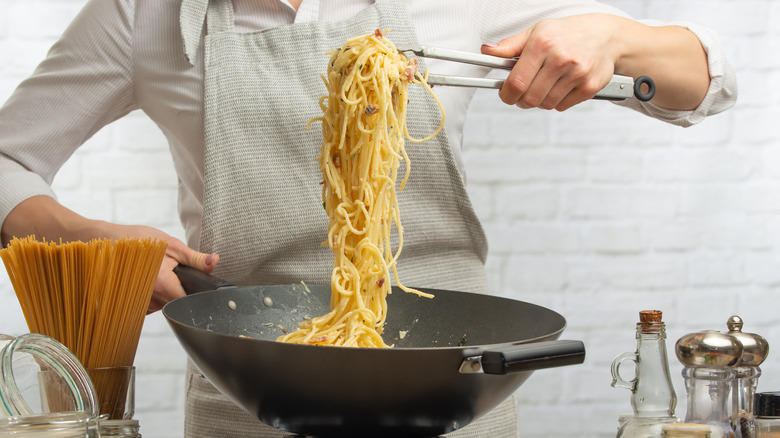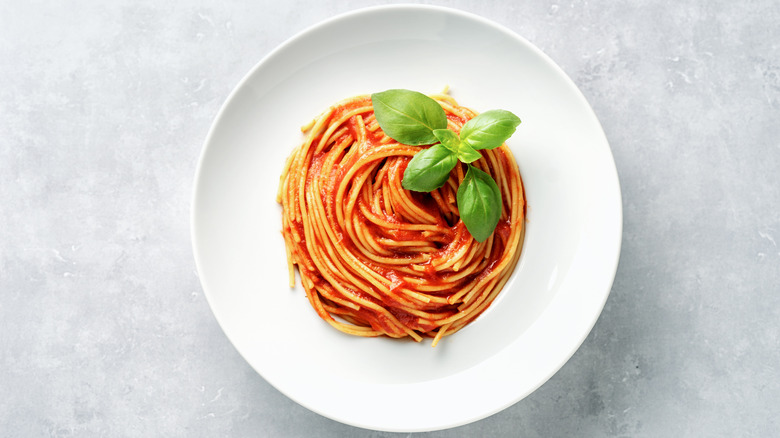The Real Reason You Should Always Finish Your Pasta In The Sauce
There's a big difference between pasta and sauce thrown together and a flavorful pasta dish with a well-seasoned sauce clinging to every bite. Though restaurant-quality pasta may seem out of reach, the truth is fantastic pasta is easy to achieve at home. You can transform uninspired pasta into a delicious meal with a few simple steps.
The key to making restaurant-quality pasta is to take it out of the boiling water well before it's cooked and finish the process in the sauce itself. "A chef once told me to cook my fresh pasta 70 percent in the water and 30 percent in the sauce," The Heritage's John Underbrink told AllRecipes. "This is because cooking the pasta in the sauce allows it to absorb the flavors as well as coat itself in the sauce much more nicely." In addition to flavor absorption, the pasta's water mixed with fat and acid from the sauce undergoes emulsification, explains MyRecipes. Emulsification means blending two incompatible liquids; combining oil and vinegar into a vinaigrette, for example.
To emulsify pasta sauce, you'll need to use starchy pasta water, then introduce fats like oil or butter, and blend them with heat and stirring. The combination of ingredients will make a thicker, creamier, more evenly layered sauce that will cling to the pasta rather than slip off. Finishing the pasta in this emulsified sauce ensures an even coating. Finally, the pasta absorbs some of the sauce's flavors. Here's how to do it.
Gather Your Tools
First, prepare your supplies and ingredients. You'll need a large pot to boil the pasta and a second large pan for the sauce and pasta mixture. A large saucier with sloped sides is an excellent option. You can use the pan for the pasta water for the second step in a pinch. Still, you'll need to heat your sauce before you add the pasta, and the pasta may cool as it waits, which can lead to overcooked and extra starchy pasta.
Get out supplies for your preferred method of draining pasta, whether a colander or tongs. Tongs or a large spoon will help you toss the pasta in later steps. If you're planning on using parmesan, prepare a grater and any supplies for prepping herbal garnishes like basil.
Some suggest serving pasta in warm bowls. It's easy to warm a serving bowl by putting hot water in it a few minutes before serving. Once pasta is ready, pour out the water, give it a quick dry, and have a satisfyingly warm serving bowl for your pasta.
Prepare Your Ingredients
For ingredients, you'll need whichever type of pasta you plan on using. A good gauge for servings is 3 oz per person, according to MyRecipes. For a bunch of dry spaghetti, one serving is about a quarter-sized diameter. If you're making your own sauce or following a multi-ingredient recipe, skip ahead to preparing the pasta.
If you're using store-bought sauce, you can still dramatically improve the result by following the next few steps. For tomato-based sauces, you'll need about 1 ½ cups of sauce for every pound of pasta, according to Delallo. For cream-based sauces, use even less, no more than one cup per-one pound of pasta. These amounts may seem too small. Many people over-sauce their pasta dishes because the sauce doesn't stick to the pasta. With emulsion, the sauce will become thicker and adhere to the pasta in an even coating, so much less is needed, writes MyRecipes.
Additionally, you may want cold butter (or your preferred non-dairy alternative), olive oil, and grated parmesan on hand for better flavor and added creaminess. Additionally, get out any taste-improving additions like salt, pepper, and garnishing herbs.
Get started
Add a large amount of water to your pasta cooking pot. You need a fair amount to ensure that the water temperature doesn't drop when you add the pasta, which can add cooking time and affect the pasta's texture. Next, salt the water generously. You'll need about one tablespoon of salt per quart of water, according to Mark Ladner, executive chef at Del Posto (via Smithsonian). Finally, as Italian chef Lidia Bastianich told the Smithsonian, "Do not — I repeat, do not — add oil to your pasta cooking water! And that's an order!" Adding oil at this stage creates a slick barrier between the pasta and sauce, preventing the sauce from sticking to the pasta.
Set the water-filled and covered pot on the stove on high heat and wait for the water to reach a big bubbling boiling point. As you wait for the water to reach a boiling point, you can take this time to prep any ingredients you'll add later. This moment is an excellent time to grate your parmesan, wash and chop herbs, etc. Once you've set yourself up for later steps, it's time to tackle the sauce.
Emulsify your sauce
As the water boils, begin to prepare your sauce. If you're following a specific sauce recipe, you can skip ahead. Read on if you're using a store-bought tomato sauce and would like to begin emulsification before the pasta even enters the sauce.
Get out the pan, ideally a saucier, which you will use to prepare the sauce and eventually add in the pasta. Add in the appropriate amount of sauce and begin to heat. Now the butter comes in. MyRecipes suggests adding the butter to the sauce slowly, about half a tablespoon at a time. You're aiming to thicken the sauce to the point that when you run a spoon through it, and you can see the bottom of the pan, the sauce doesn't quickly fill in the gap. Stop at about two tablespoons. The acid and the fat will emulsify, creating a thicker, creamier sauce. The sauce should shine, but the butter shouldn't pool on the sauce. Keep the sauce warm as you wait for the pasta to cook.
Cook the pasta, but not all the way
Once the pot of water has reached a rolling boil, add the pasta, stirring occasionally. You'll want to cook the pasta until just before it's al dente since you'll finish cooking it in the sauce. This will be about 1-4 minutes before the package's suggested time, says Kitchn.
However, you will be the best judge of when the pasta is ready to take out. Use Jacob Kenedy's method from The Geometry of Pasta: "start tasting the pasta at 15-20 second intervals, from a minute or two before you think the pasta might be ready" (via Smithsonian). Al dente means that the pasta is no longer chewy. Since you're looking for the pre-al dente texture, it's ok if the pasta is a little tough in the middle. The pasta will continue to cook to the right texture once it's in the sauce.
Once the pasta has reached the ideal pre-al dente texture, reserve at least a cup of the pasta water for the next steps, suggests MyRecipes. Use a colander or tongs to remove the pasta from the water. Don't rinse the pasta or add oil. Both prevent the sauce from coating and sticking to the pasta. In her cookbook Everyday Pasta, Giada de Laurentiis explains why: "the starch on the surface contributes flavor and helps the sauce adhere." If you rinse the water, you rinse away the starch (via Smithsonian).
Finish Cooking the Pasta in the Sauce
Before putting the pasta in the sauce, make sure to raise the sauce's heat to a bubbling simmer, says MyRecipes. Add the pasta to the sauce, stirring as you do. Now is the time to add the pasta water. Do so about a tablespoon or two at a time. As the sauce simmers down, add more pasta water. You're looking for a consistency that's not too dry and not too wet.
Every type of pasta acts differently, so keep a close eye on the sauce and taste test the pasta periodically. Getting an al dente texture should take about 1-2 minutes, says Delallo. However, trust your taste. You're looking for pasta that is no longer chewy or chalky, says AllRecipes. Ideally, the perfect al dente pasta should be easy to bite through, with no stiff resistance, but not yet soggy per Serious Eats.
Season and Serve
If the pasta looks like it's getting too dry, it's ok to add more pasta water. Once you're simmering the water, sauce, and pasta together, you can add a drizzle of olive oil to further the emulsification, as suggested by Serious Eats. For even creamier pasta, you can add a bit of grated parmesan every time you add more pasta water, writes MyRecipes. Simply continue to stir to help the sauce get thicker and coat the pasta.
Once the pasta is al dente, remove the pot from the stove. This moment is the last chance to adjust the pasta's consistency. Add more pasta water if the consistency is too dry (via Serious Eats). Salt and pepper to taste. If desired, you can add one more drizzle of olive oil. Then, garnish the pasta with grated parmesan and any herbs. Get out those heated bowls and serve. To get the best texture and flavor, eat right away. Enjoy and buon appetito!
